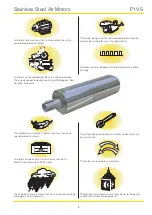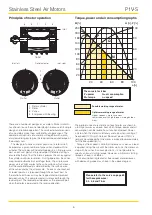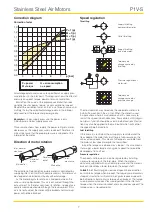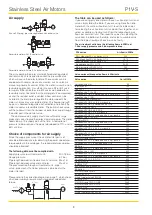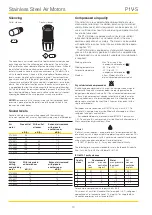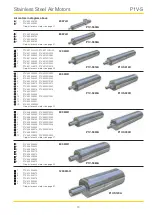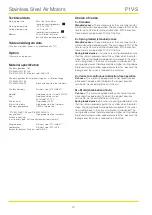
18
Stainless Steel Air Motors
P1V-S
Serious, even fatal, damage or injury may be caused by the hot
moving parts of the P1V-S motors in the presence of explosive gas
mixtures and concentrations of dust.
All installation, connection, commissioning, servicing and
repair work on P1V-S motors must be carried out by qualified
personnel taking account of the following
• These instructions
• Notices on the motor
• All other planning documents, commissioning instructions and
connection diagrams associated with the application.
• Provisions and requirements specific to the application
• Applicable national/international regulations (explosion protection,
safety and accident prevention)
Real life applications
P1V-S motors are designed to provide rotary movement in
industrial applications, and should only be used in accord-
ance with the instructions in the technical specifications in the
catalogue, and within the operating range indicated on the
motor housing. The motors meet the applicable standards and
requirements of the Machinery Directive
94/9/EC (ATEX)
The motors must not be used as brakes in
explosive atmospheres.
Braking involves driving the motor against the direction of
rotation for which the motor is supplied with compressed air.
The motor is then operating as a compressor, and there is a
corresponding increase in temperature.
The motors must
not
be used underground in mines suscep-
tible to firedamp and/or combustible dust. The motors are
intended for use in areas in which explosive atmospheres
caused by gases, vapours or mists of combustible liquids, or
air/dust mixtures may be expected to occur during normal use
(infrequently)
Checklist
Before using the motors in a potentially explosive atmosphere,
you should check the following:
Do the motor specifications match the classification of the area
of use in accordance with Directive 94/9/EG
(previously ATEX 100a)
• Equipment group
• Equipment category
• Zone
• Temperature class
• Max. surface temperature
1. When installing the motor, is it certain that there is no potentially
explosive atmosphere, oil, acids, gases, vapours or radiation?
. Is the ambient temperature as specified in the technical data in the
catalogue at all times?
3. Is it certain that the P1V-S motor is adequately ventilated and that
no additional heat is added (for example in the shaft connection)?
4. Are all the driven mechanical components ATEX certified?
Additional safety instructions for installation in explosive atmospheres
Installation requirements in potentially explosive at-
mospheres
• The temperature of the supply air must not exceed the ambient
temperature.
• The P1V-S may be installed in any position.
• An air treatment unit must be attached to the inlet of the P1V-S air
motor.
• In a potentially explosive atmosphere, none of the motor ports may
be blocked because this may cause an increase in temperature.
The air from the port must be taken to the silencer or, preferably,
outside the potentially explosive area.
• The P1V-S motor must be connected to ground at all times, through
its support, a metallic tube or separate conductor.
• The outlet of the P1V-S motor must not open within a potentially
explosive area, but must be passed to the silencer or, preferably,
removed and released outside the potentially explosive area.
• The P1V-S motor may only drive units that are ATEX certified.
• Ensure that the motor is not exposed to forces greater than those
permitted in accordance with the catalogue.
Measuring the temperature on the outside of the
P1V-S motor (only when used in potentially explosive
areas)
During the commissioning process, it is essential to measure
temperature increases at the indicated positions on the
outside of the P1V-S motor.
These measurements can be taken using standard thermom-
eters.
Checking the motor during operation
The motor must be kept clean on the outside, and a layer of
dirt thicker than 5 mm must never be allowed to form.
Strong solvents should not be used for cleaning, because they
can cause the seal (material NBR/FPM) around the drive shaft
to swell, potentially increasing the temperature.
Summary of Contents for 1P1V-S020A00005
Page 66: ...66 Stainless Steel Air Motors P1V S...
Page 67: ......


